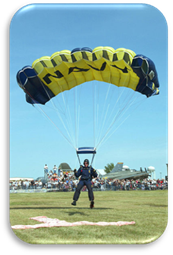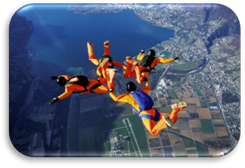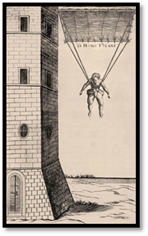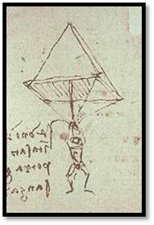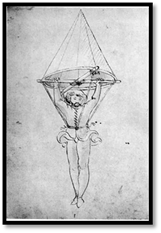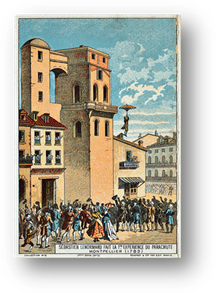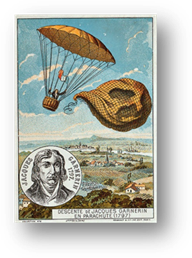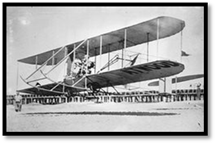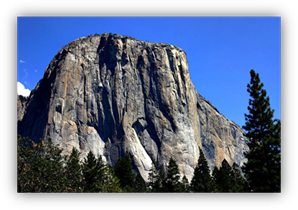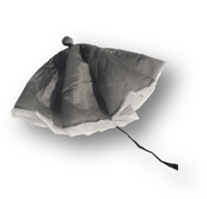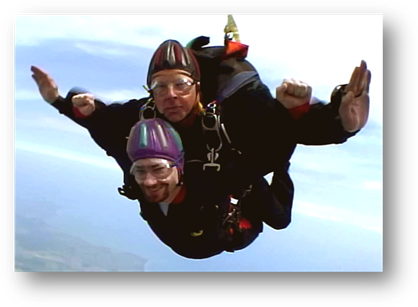PARACHUTING/BASE
JUMPING
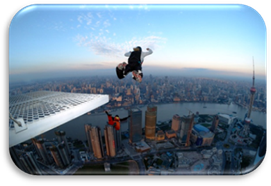
Unit
Overview
In
this unit, you will be introduced to the outrageous outdoor extreme sports of
Parachuting and BASE jumping. The sport of parachuting is where participates
jump out of an airplane and perform maneuvers before opening the parachute and
attempting to land accurately back to the earth. Parachuting is also known as
skydiving. BASE jumping grew from the
sport of parachuting. Base jumps are
usually made from lower altitudes than skydiving. A base jump is done off of an
object as a jump platform.

You will also learn more about the Mypyramid Food Guidance System. The U.S. Food Guide MyPyramid,
provides web-based interactive and print materials for consumers and
professionals. The new icon stresses activity and a proper mix of the different
food groups. https://www.choosemyplate.gov/
Parachuting
Parachuting is the action of departing from an aircraft and returning to earth with the aid of a parachute. The word parachute means “that which protects against a fall”. It may or may not involve a certain amount of free-fall. Free-fall is the motion of the body where gravity is the only force acting upon it. Skydiving is performed as a recreational sport and a competitive sport. It is also used to deploy military personal and occasionally for fighting forest fires.
BASE
Jumping
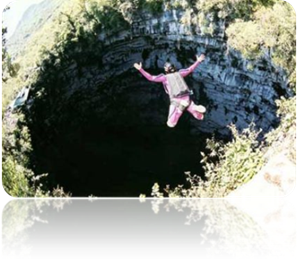
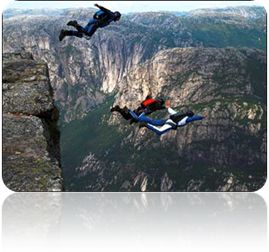
For most BASE jumpers, leaping out of an airplane at 15,000 feet and freefalling at 100 MPH is not daring enough. BASE is short for the four categories of fixed objects from which a person can jump from. “B” refers to buildings and monuments. “A” refers to antennae towers. “S” refers to spans like bridges. “E” refers to the earth like cliffs canyons and gorges.
BASE jumping is a fast expanding extreme sport where individuals are putting their lives in danger for the ultimate adrenaline rush. Unlike skydiving, BASE jumping has no reserve chute, and once a jumper leaps off of a structure they fall for about 20 seconds at speeds up to 120 miles per hour. Most people believe that this sport is for lunatics because the fact is that if something goes wrong you will probably die.
BASE
jumpers jump off of cliffs and man-made objects, usually at a low altitude with
only seconds to open their parachute. At
this point, they have no time at all to deal with problems or malfunctions that
may occur during their jump. BASE
jumping is so extremely dangerous and risky that it is illegal in many
places.
Go
to this link for excellent videos of BASE jumping:
History
of Parachuting and BASE Jumping
Veranzio’s 1595 design Leonardo DaVinci
sketch The oldest known depiction of a parachute
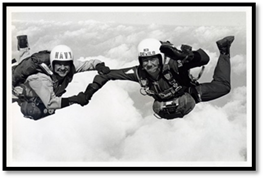
The oldest known depiction of a parachute dates back
to the 1470’s. The oldest parachute
design appears in an unknown Renaissance Italian manuscript. Later on in the 1495 Leonardo DaVinci designed a pyramid-shaped wooden framed parachute.
Lenormand jumps from the tower of Montpellier
1783.
The modern parachute was invented by Louis-Sebastein Lenormand in France in the late 18th century. Lenormand made the first recorded public jump in 1783. His design looked very much like a huge umbrella. Two years later in 1785 Aaron Seitler jumped from a hot air balloon. Seitler’s first parachuting demonstration was actually conducted with a dog as the passenger.
As the parachute developed, the focus was on a more compact design. Early parachutes were made of linen stretched over wooden frames. The newer design used folded silk which was stronger and lighter. Andre Garnerin in 1797 made the first jump using the newer designed parachute. Garnerin also invent the vented parachute, which improved the stability of the parachute.
In 1911 Grant Morton made the first parachute jump from an airplane. The jump was made from a 1911 Wright Model B airplane in Venice Beach, California. Morton’s parachute was held in his arms as he left the aircraft.
Wright Model B
Airplane
During World War I, parachutes were used as rescue devices. The first emergency
bailout from an airplane occurred in 1922.
This led to the early experiments in extended freefall. Beginning with Italy several countries began
dropping soldiers behind enemy line in 1927.
After World War II, a surplus of parachutes and former soldiers with the training to jump resulted in the growth of parachuting as a recreational sport. The first skydiving centers opened in the mid 1950’s.
![]() New Jersey: Graduation at
Waves Parachute School [00:54]
New Jersey: Graduation at
Waves Parachute School [00:54]
![]() Fort
Benning, GA: A Parachute Batallion Demonstration
[01:06]
Fort
Benning, GA: A Parachute Batallion Demonstration
[01:06]
B.A.S.E.
Jumping
Evidence shows that using a parachute to fall from
fixed objects has been practiced for the last 900 years. Unlike the early leaps
in the 12th century, today’s BASE jumps emphasize leaps without a
previously inflated parachute.
It was not until the 20th century that
fixed-object jumping began to become popular because of the sport of
parachuting from an airplane. The early
1900s saw the bridge jump and a stuntman’s static line jump from the Statue of
Liberty. Fredrick Law jumped from the
Statue of Liberty in 1912. By the
1960’s, the sport of parachuting developed to the point that experienced
skydivers began to try their sport from non-flying objects. About one jump per year occurred from cliffs,
El Captain in Yosemite National Park, oil well derricks and some odd
bridges. Most of these attempts were
poorly recorded so little is known of them except they all were done with the
contemporary round canopies with varying degrees of success.
“El Captain Yosemite
National Park”
Carl Boenish is considered
the father of modern BASE jumping. Carl was a freefall cinematographer who
filmed the first jumps from the “El Captain” in Yosemite National Park in
1978. These were the jumps that
popularized BASE jumping. The term “B.A.S.E.” was invented by the filmmaker and
his wife Jean. The very sport that Carl developed and loved killed him in 1987.
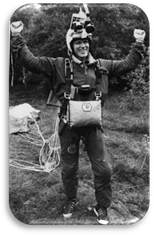
Carl Boenish
BASE Jumping Legality
BASE jumping has always been considered an extreme
sport largely due to the extreme danger associated with the sport. Jumping off of buildings, towers bridges and cliffs
in most places are against the law. The
National Park Service does not allow jumping off of earth objects and park
structures in all National Parks. Anyone caught will face up to a $2,000 in
fines and the cost of any rescue operations if necessary
BASE jumping from buildings located within city
limits is almost always illegal. The
risk of people being injured and traffic being disrupted is too great. Police have quickly arrested BASE jumpers who
have jumped from the Eiffel Tower and the St. Louis Archway. However, there are some structures that
jumpers are permitted to jump from on special occasions. On the third Saturday in October, people are
permitted to jump from the New River Gorge Bridge in Fayetteville, West
Virginia. All four lanes of the bridge
are closed to traffic on this day to commemorate the 1977 completion of the
bridge. “Bridge Day” is the only day of the year people are permitted to BASE
jump off of the bridge into the New River Gorge 876 feet below. Around four hundred Jumpers participate each
year. It is also estimated that close to
80,000 people attend the overall event each year.
St. Louis Archway
Eiffel Tower
New River Gorge Bridge
BASE
jumping is an extremely dangerous sport. It is strongly recommended to have
thousands of regular skydiving jumps in before attempting your first BASE jump.
The
Parachute Deployment Sequence
How does a Parachute Work?
A parachute
works on the principal of “air resistance”.
To better understand this principle, drop a stone and a feather from the
same height. The stone drops down to the
earth instantly while the feather floats down to the earth at a slower rate of
speed. When an object falls through the
air, it creates a path by pushing aside the molecules and atoms in the air. The
stone drops quickly because of its heavy mass.
The feather however, has little mass and a larger surface area finding
it harder to shove aside the molecules and the atoms in the air. This slows down the downward fall of the
feather like a parachute. The parachute
makes the air molecules slow down the fall making it a safe landing.


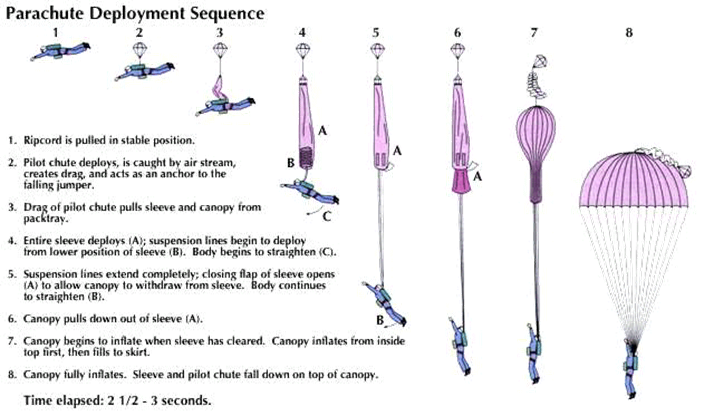 From Encyclopedia Britannica, Inc.
From Encyclopedia Britannica, Inc.
Parachuting
Equipment
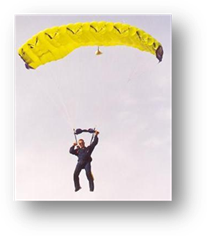

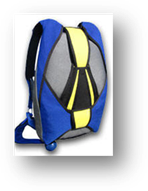
Main Chute
AAD
Container
Pilot
Chute
A parachute today has six basic parts.
![]() The
main parachute, also known as the
main canopy
The
main parachute, also known as the
main canopy
![]() The
pilot chute is a small parachute
that is used to pull out and open the main chute. The skydiver throws out the pilot chute and
it catches the wind and pulls on a long piece of nylon webbing known as the Bridle. The bridle pulls the main canopy
out of the container so that it inflates.
The
pilot chute is a small parachute
that is used to pull out and open the main chute. The skydiver throws out the pilot chute and
it catches the wind and pulls on a long piece of nylon webbing known as the Bridle. The bridle pulls the main canopy
out of the container so that it inflates.
![]() The
reserve chute also known as the
second chute, is available in case the main chute fails to open. If the main chute fails for some release the
skydiver can cut away the main chute and deploy the reserve.
The
reserve chute also known as the
second chute, is available in case the main chute fails to open. If the main chute fails for some release the
skydiver can cut away the main chute and deploy the reserve.
![]() The
container, which is a backpack that
holds the main chute and the reserve chute. The container also has thick
shoulder and leg straps to keep the container firmly attached to the skydiver.
The
container, which is a backpack that
holds the main chute and the reserve chute. The container also has thick
shoulder and leg straps to keep the container firmly attached to the skydiver.
![]() The
lines which run from the main chute
to the container through a pair of thick straps are called Risers. Risers are the lines, which
run from the parachute to the container through a pair of thick straps called
the risers. Most parachutes today have
five sets of lines called the A-line, B-lines, C- lines, D-lines and brake
lines.
The
lines which run from the main chute
to the container through a pair of thick straps are called Risers. Risers are the lines, which
run from the parachute to the container through a pair of thick straps called
the risers. Most parachutes today have
five sets of lines called the A-line, B-lines, C- lines, D-lines and brake
lines.
![]() The
AAD is known as the automatic
activation device. This will
automatically open the parachute if something goes wrong like the jumper passes
out.
The
AAD is known as the automatic
activation device. This will
automatically open the parachute if something goes wrong like the jumper passes
out.
The
Ram-air Parachute
Just about everyone today uses the Ram-air canopy
parachute. This parachute is lightweight
and is rectangular or square in shape. The design of the canopy makes the
parachute act like a wing of an airplane.
Instead of coming straight down like a round parachute, the new design
actually allows the jumper to glide back down to the Earth.
This parachute also permits the skydiving to have a great deal of control over
the flight of the parachute. A jumper controls
the parachute with a set of toggle handles that can actually allow the skydiver
to stop on the ground with great precision.
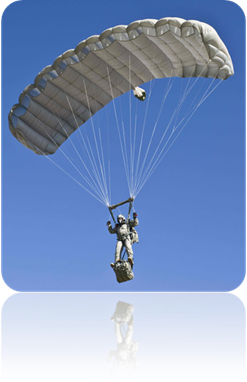
Parachute
Safety
Here
are some safety tips to follow before parachuting.
ü Research the parachute facilities you are planning to use.
ü Inspect the gear you are going to use. Make sure your
parachute was packed by a trained certified person according to legal
standards.
ü Make sure you use an Automatic Activation Device that will
automatically deploy the parachute in case of an emergency.
ü Most accidents occur because of turbulence or
inexperience. Therefore, ask, listen and
learn as much as you can from your skydiving trainer before jumping off the
plane.
ü If you are having second thoughts about jumping, you can always jump with the instructor. This is called Tandem skydiving which is a popular training method for first time skydivers. Tandem skydiving is where the student is connected to the instructor by a harness.
In the next unit you will learn about the extreme
skydiving sports of Freeflying, Sky Surfing and Wing
Suit flying.
The new food pyramid shows food
groups as a series of differently-sized colored stripes. Based upon the 2005 Dietary Guidelines,
the United States Department of Agriculture (USDA) has launched the MyPyramid
Food Guidance System. MyPyramid, released in April 2005, is
an update of the U.S. Food Guide Pyramid. MyPyramid
provides web-based interactive and
print materials for consumers and professionals. The new icon stresses activity and a proper
mix of the different food groups. The pyramid is now called MyPyramid because it is about healthy lifestyle choices and
how these need to be personalized depending on the individual. Individual pyramids can be produced based on your age, sex, and activity
level.
The
stripes are different widths to show how much of a person's daily food intake
should be made up of that food group. So the orange band is much wider than the
yellow one because people need to eat a lot more grains than fats and oils.
What we eat is tied to how much we exercise. Teens need to eat well to get the
nutrients that help the body grow. But teens that are extremely active need
additional food so they can fuel their activity levels in addition to their
growth. And people who are less active
need to eat less food so they can avoid gaining weight.
![]() MyPlate: Guidelines for Healthy Living (16:52)
MyPlate: Guidelines for Healthy Living (16:52)
|
Yellow Oils |
|
What are Oils?
Oils are fats that are liquid at room temperature, like the vegetable
oils used in cooking. Oils come from many different plants and from fish. Oils
can include corn oil, olive oil and soybean oil. There are some oils that are used mainly as
flavoring like walnut oil and sesame oil.
Solid fats are fats that are solid at room temperature, like butter and
shortening. Solid fats come from many animal foods and can be made from
vegetable oils through a process called hydrogenation.
|
Purple Meat & Beans |
|
Which Foods are in the Meat,
Poultry, Fish, Dry Beans, Eggs, and Nuts (Meat & Beans) Group?
All foods
made from meat, poultry, fish, dry beans or peas, eggs, nuts, and seeds are considered
part of this group. Dry beans and peas are part of this group as well as the
vegetable group. Most meat and poultry choices should be lean or low-fat. Fish,
nuts, and seeds contain healthy oils, so choose these foods frequently instead
of meat or poultry. Some commonly eaten choices in the Meat and Beans group are
beef, chicken, fish, lamb, black beans, tofu (bean curd made from soy beans),
and kidney beans.
Physical
Activity

This is
represented by a person climbing steps on the pyramid. The USDA recommends at
least 30 minutes of moderate to vigorous activity per day. However, in some cases,
such as people trying to shed extra pounds, 60 to 90 minutes are recommended.
Discretionary
Calories

These are
represented by the uncolored tip of the pyramid. These include items such as
candy high-calorie beverages, or additional food from any other group. A calorie is the amount of heat required
to raise the temperature of one kilogram of water by one degree at one
atmosphere pressure; the calorie used by nutritionists to characterize the
energy-producing potential in food. What does that mean? It is somewhat
complicated. For the purposes of this course it is simply important to remember
that a calorie is characterized by the energy-producing potential in food.
Key Points of ChooseMyPlate
Combine exercise with eating well. The figure climbing stairs at the side of the pyramid
reminds us that exercise benefits every part of our bodies, including the mind.
Eat a variety of foods. The different color bands in the pyramid send the message
that it's important to eat lots of different foods.
Eat foods in moderation. The colored bands that show each food group are wider at
the bottom of the pyramid than they are at the top. That's a reminder to people
that they can eat lots of some foods in each group, but that other foods in
this group should be limited.
Practical Advice on Eating Right and
Exercise – American kids, teens, and adults are
getting heavier and less healthy. A lot of this is because we're becoming a
nation of couch potatoes. We're spending more time in front of computer screens
and TV sets than meeting up with friends and playing sports. We're sitting in
cars instead of walking or biking to our destinations.
Remember to check out the website, called ChooseMyPlate, to find specific food and exercise guidelines. At this site, you can get personalized recommendations about which foods to eat and how much, including estimates of the number of calories needed to stay at a healthy weight. To create a personal profile that shows what you should eat for your age, gender, and activity level, visit https://www.choosemyplate.gov/
